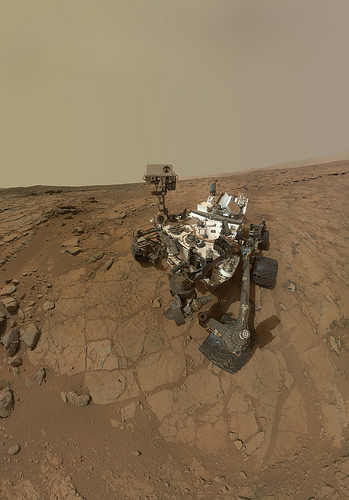By Ashley O’Neill (Contributor) – Email
Print Edition: February 6, 2013
NASA’s latest Mars rover, Curiosity, sparked curiosity of its own when it sent back pictures for the first time on January 23.
Curiosity is fitted with a Mars Hand Lens Imager (MAHLI), a camera which captures high-definition 13.9 micrometers per pixel resolution images and includes its own LED lighting system.
The photos Curiosity sent to Earth last month depict back amazingly clear images of a Martian rock called “Sayunei.” NASA scientists are taking particular interest in this rock and these images; prior to Curiosity snapping the photos, the rover’s wheel scuffed the corner of the rock which caused a fresh, sand-like sample to come loose from the ground. The scientists at NASA are filled with anticipation as to what this sand-like material may be, and think it could take them one step closer to finding out more about our closest planetary neighbour.
Two different LED settings were used for picture-taking that night: white LEDs and ultraviolet LEDs. Each illumination provides a different view. The image lit up by white lighting allows the viewer to see textural detail and surface features cast by shadows. As for the ultraviolet light, Ken Edgett, the MAHLI Principal Investigator of Malin Space Science Systems in San Diego, explained on the NASA site that the light would pick up any fluorescent minerals. If they find the colours green, yellow, orange or red under the ultraviolet LEDs, there may be traces of fluorescent material on Mars – which would point to the presence of vegetation.
NASA is not stopping at just collecting photographs for evidence and observations. When Curiosity was deployed on November 26, in 2011, NASA also intended for the rover to collect soil samples. This will be the first time any rover has attempted to collect a physical sample from a planet.
On January 27, the rover just finished preparing drills and carrying out “pre-load testing” around Sayunei to make sure the ground is secure enough to drill in.
“We are proceeding with caution in the approach to Curiosity’s first drilling,” said Daniel Limonadi, lead surface sampling and science systems engineer for Curiosity (again quoted on the NASA site). “It will be the first time any robot has drilled into a rock to collect a sample on Mars.”
Eventually, Curiosity will try to assess the amount of radiation in the environment from the sample. For now, though, Curiosity will just be testing the surface of the planet. This way scientists can observe how the rock reacts to the sudden temperature drop overnight and how the robot’s machinery deals with the stress of drilling.
NASA is expecting to start drilling in early February, but it could take weeks or months until Curiosity has anything more than photos to share.


